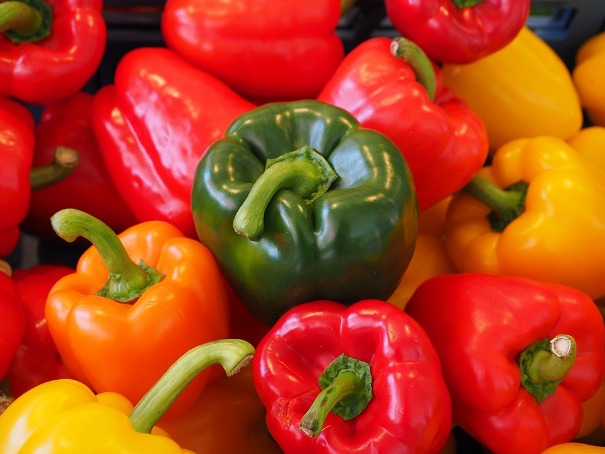
The correct choice of suitable pepper seeds for further cultivation primarily depends on the properties of the varieties to grow and bear fruit, taking into account the climate characteristics of a particular region. This applies to the characteristic variability or even unpredictability of weather conditions and the resistance of the plants themselves to possible cold weather with the ongoing formation of ovaries and ripening of the fruits themselves.
Variety selection rules for northwest regions
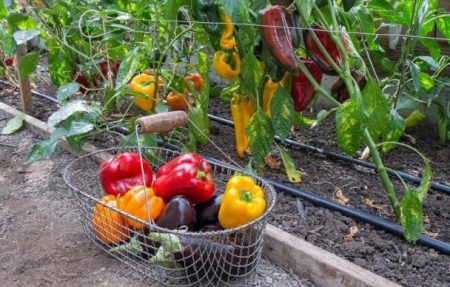
Suitable varieties of pepper for growing in the northwestern regions are characterized by stunted bushes and early ripening of fruits - about 100 - 105 days from the appearance of seedling sprouts. Tall bushes from the category of plants with medium and late ripening can be grown only if there are fully protected heated greenhouses. The peculiarity of using hybrids in such cases is the ability to get a good harvest with large fleshy fruits, observing only the minimum care requirements.
Most varieties of pepper are characterized by exactingness to:
- full sunlight;
- warm air;
- moderate regular watering of the soil with periodic use of mineral fertilizers.
Since the northwestern regions are characterized by long spring frosts and cloudy weather, at least until the third decade of March, the seeds are planted for growing seedlings 75 days before the planned planting in permanent soil, around February 15-17. It takes about 5 months to grow varieties with large juicy fruits, so the first harvest can be expected in the second half of July.
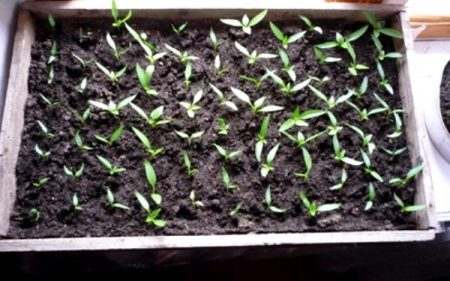
If the cultivation of peppers is planned in greenhouses, then the resistance of plants to cold snap and prolonged droughts are not mandatory selection criteria. When working with Dutch varieties and hybrids, it should be borne in mind that their growing season lasts about 7 months. The optimal solution for obtaining a good harvest of peppers over a long period is to plant several varieties of peppers that differ not only in color and size of the fruit, but also in the ripening period. Late varieties should be a minimum quantity.
Variety Overview
When selecting seeds of different varieties of pepper, one should take into account their exactingness to the soil composition, the required number of irrigation during the week, the binding and pinching of bushes, the preference for fertilizing with mineral and organic complexes. If the selected varieties are similar in their requirements, caring for the plants themselves will be simpler and easier.
Snow flake
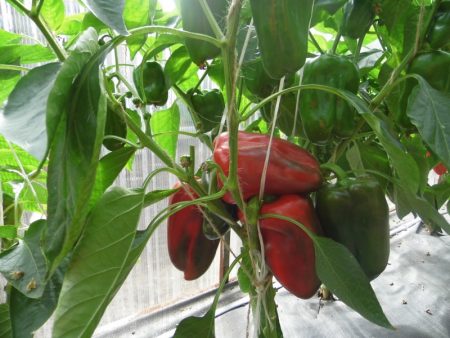
An early ripe hybrid of pepper, the crop of which can be harvested already 105 days after the appearance of the first seedlings sprouts. At this stage, the technical maturity of dark green fruits sets in. The fruits of plants become fully ripe on day 120 and have a rich red color. Pepper bushes grow to 1.6 - 2.1 m in height, but remain compact. The fruits differ in the shape of a curved prism with rounded tops. The surface of the fruit is smooth with subtle ribbing. The average weight of peppers is about 120 g. The thickness of the dense juicy pulp is 5 - 7 mm, which preserves the characteristic crispness.
When planting bushes, one should observe a density of not more than 3 plants per 1 sq.m. At the same time, it will be possible to collect about 12.5 - 13 kg of a full crop from them.The hybrid is resistant to possible tobacco mosaic damage. The formation of bushes is recommended in 2 main stems with regular pinching of the side shoots. Timely tying will protect the hands from a fracture.
Mazurka
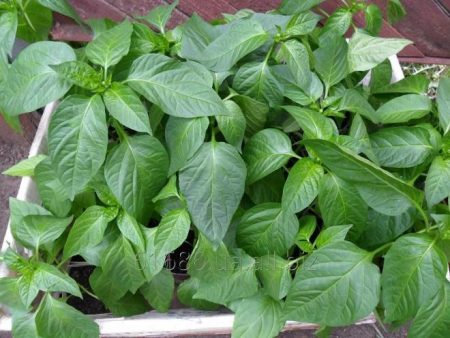
The hybrid has a rich sweet taste of the fruit and belongs to the category of medium early plants. The growing season lasts about 110 - 112 days from the moment the first seedlings emerge. The bushes are indeterminate, therefore, pinching the tops is carried out in early July. This allows useful nutrients to be directed to the development and ripening of fruits, and not to the further growth of stems and the density of tops.
The fruits of the hybrid are distinguished by a cuboid shape and a smooth glossy surface. At the stage of technical ripening, peppers have a dark green color, which eventually becomes saturated with red. The fruits grow large enough and can weigh about 130 - 180 g. In this case, the juicy pulp differs in thickness by 5 - 6 mm and at both stages remains with a balanced sweet taste without bitterness.
The hybrid is suitable for cultivation for further sale. Plants are resistant to possible vertex rot, late blight and tobacco mosaic damage.
Pinocchio
The hybrid has an increased yield with minimal compliance with care requirements. It belongs to the category of early ripening plants that do not require clipping of lateral shoots and pinching of the tops. The bushes grow quite high from 70 to 100 cm. Moreover, they have a sprawling shape and dense green foliage. The fruit ripening period from the moment of seedling emergence lasts 88-100 days. The first frontier indicates the technical readiness of dark green fruits for use, and the second is the moment of full biological ripening of peppers with rich red color and glossy gloss.
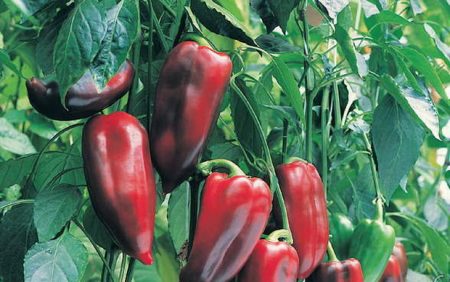
The average weight of sweet juicy fruits is about 100 - 115 g, so you can count on 10.5 - 14 kg of crop per 1 sq. M plot. The thickness of the dense pulp is 5 - 6 mm, which is necessary for the characteristic crispness of pepper. The use of fruits is universal, because it is suitable for fresh use, in the preparation of hot dishes, as well as for canning for the winter. The immunity of plants allows us not to be afraid of possible damage by vertex rot, fusarium and tobacco mosaic, which manifests itself in the form of brown spots on leaves, stems and fruits.
Spring
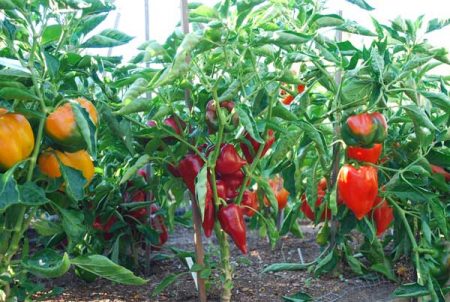
The fruit ripening period until technical readiness lasts about 92 - 111 days, so the variety is classified as early ripe. At the stage of biological maturity, pepper from a saturated green color turns into a bright red color. The bushes themselves grow quite high and require timely careful garter of the hands. Ripening peppers have a conical shape with a weak ribbing and an average weight of about 85 - 110 g. At the same time, the thickness of the pulp is about 4 - 6 mm, while maintaining the aroma and balanced taste of the fruits with their crunch.
Subject to the rules of care, you can expect to get 10 - 12 kg of crop from 1 sq.m. Plants themselves can be slightly affected by vertex rot, therefore, require preventive spraying. An important feature of the variety is the increased content of vitamin C - about 255 mg in one average fruit.
Fiery
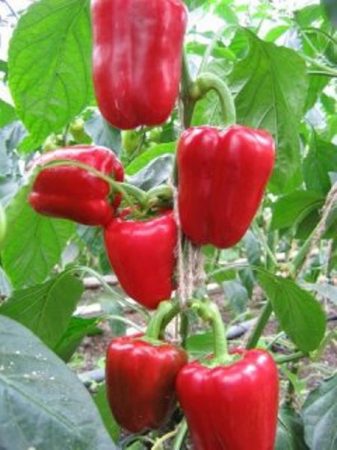
Pepper is an early ripe hybrid, so when grown it should count on a high yield of bushes, a balanced sweet taste and the general unpretentiousness of the plants in the care. The stage of technical ripening of fruits begins on 100 - 104 days. The height of the bushes reaches 1.4 - 1.8 m, which makes them binding to an additional support. The onset of biological ripening of the fruit is evidenced by their rich red color and glossy surface luster.
Pepper fruits have a prismatic shape with a weak ribbing and a rounded tip, as well as an average weight of about 80 - 95 g. The wall thickness is 5 - 6 mm, which ensures long-term preservation of the taste and crisp qualities of the crop after its collection. Subject to the rules of care, you can expect to receive 12 - 13 kg of pepper from 1 sq. M of the greenhouse. The presence of natural immunity allows plants not to be afraid of tobacco mosaic damage.
Mercury
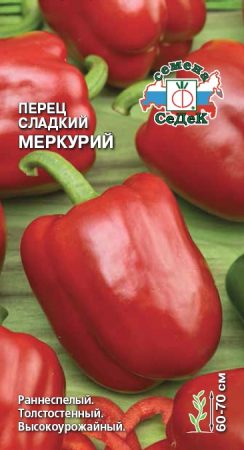
The hybrid belongs to the category of early ripening plants and is suitable for growing on closed protected soils. The moment of technical ripeness of the fruit occurs on 89 - 100 days from the moment the first seedlings emerge. At the same time, the fruits of pepper have a dark green color. At the stage of 120 - 140 days, the pepper acquires a saturated red color, which indicates its biological maturation.
The height of the bushes can reach 80-100 cm under growing conditions in closed spring greenhouses and more than 160-170 cm, if they grow in heated winter rooms. Plants form in 2 to 3 main stems and do not need to be stalked. Fruits are large in size, conical in shape with a rounded end and an average weight of about 100 - 120 g. The density of juicy pulp increases the resistance of fruits to possible mechanical damage, making the hybrid easy to tolerate lengthy transport.
Subject to the rules of care, you can expect to receive 11.5 - 12 kg of fruit per 1 sq. M of a protected plot of fertile land. Plants are characterized by a moderate resistance to damage from tobacco mosaic and apical rot. Planting plants is necessary no more than 3 - 5 pieces per 1 sq.m.
Czardas
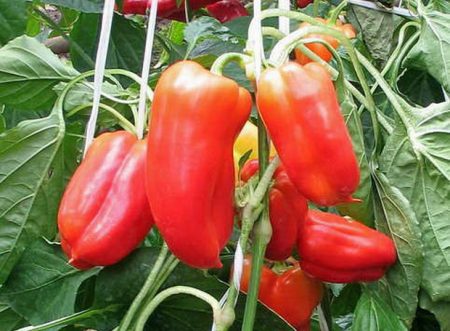
The demand for an early ripe pepper variety is due to the bright orange color of ripened fruits, as well as the ability to compactly use areas of fertile land, since plants can be planted in an amount of 5-10 pieces per 1 sq.m. At the time of technical ripening (95 - 100 days from the time of germination of the sprouts) peppers have a unique lemon tint. Full ripening of fruits occurs on 115 - 125 days.
The fruits themselves are cone-shaped, large in size and with an average weight of about 220 g. At the same time, the bushes themselves remain quite compact and only 60 - 70 cm in height. The demand for the variety among experienced gardeners is also due to the good keeping quality of the harvested crop, since it is typical for the fruits to preserve the original external appearance and taste for 2 months. The increased yield of the variety allows you to collect about 13 - 17 fruits from one bush, which leads to the receipt of 9 - 10 kg of crop from 1 sq.m.
cabin boy
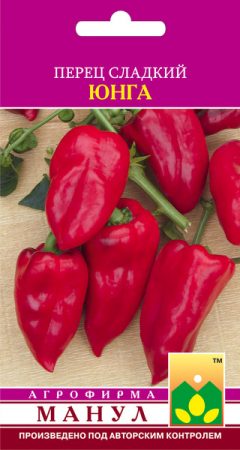
The height of the pepper bushes is not more than 50-60 cm, which allows the cultivation of crops in protected greenhouses, and their compact size provides the possibility of dense planting in areas of fertile land. The variety belongs to the category of early ripening plants, since the moment of technical ripening of fruits occurs already on 105 - 115 days after the appearance of the first sprouts. Full ripening of peppers occurs on 132 - 137 days, when the dark green color turns into a saturated red color.
The average weight of the fruit is about 130 - 185 g. At the same time, at least 8 - 13 pieces can be collected from one bush. It is recommended to plant bushes no more than 5 - 8 pieces per 1 sq. M of the greenhouse plot. This is one of the few varieties whose bushes can be planted in two seedlings in one hole. After harvesting, the cone-shaped fruits retain their taste and structural properties for 2 to 2.5 months. Pepper has a balanced sweet taste only when biological fruit ripens.
Pilgrim
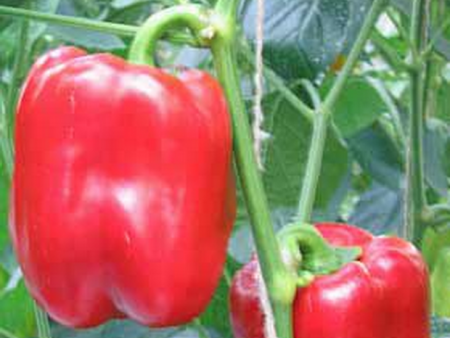
The hybrid belongs to the category of mid-ripening plants, the vegetation period of which is about 120 - 126 days. It is possible to grow exclusively on protected soils.The fruits are distinguished by a cuboid shape with smooth edges and a pronounced glossy surface. The average weight of ripened red peppers is about 100 - 140 g. The thickness of the sweet juicy pulp is 7 - 8 mm, which provides the necessary crispness.
The bushes grow tall, up to 1.8 - 2 m, so they require timely pinching of the tops in early July, as well as careful tying to an additional support. On the site should be planted no more than 3-4 plants per 1 sq.m. The bushes themselves are subject to herding in order to form 2 main stems. In this case, you can expect to receive 13 - 14 kg of crop with 1 sq. M of fertile loose earth.
The existing immunity of plants protects them from damage by tobacco mosaic and forms an average resistance against apical rot.
Lero
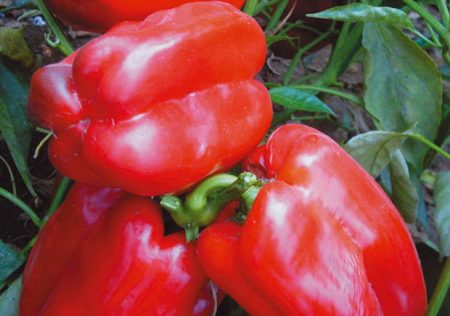
The plant is a hybrid, so you can count on high resistance to disease, increased yield of bushes, as well as earlier ripening of the fruits themselves. The technical readiness of peppers begins in 85 - 99 days, starting from the moment the shoots appear. The fruits themselves are distinguished by a heart-shaped form, as well as a smooth glossy peel, which at the time of biological maturation from light green turns red.
Fruits grow medium in size and weigh about 70 - 85 g. The thickness of the sweet pulp is 7 - 9 mm, which allows the fruits to remain crisp and juicy at the same time. Compliance with the rules of care allows you to collect about 14 - 15 kg of ripe harvest from 1 square. m plot. The hybrid is resistant to tobacco mosaic damage, and also requires careful tearing of the lower leaves so that the tops do not come into contact with the ground.
Lumina
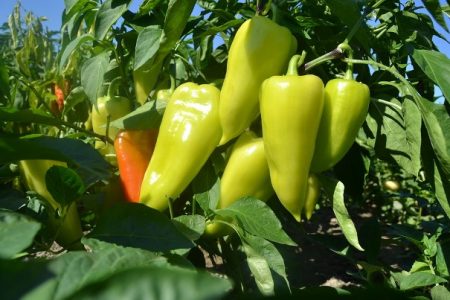
The pepper variety is characterized by short bushes and a larger first crop in the form of fruits weighing about 115 - 120 g. The subsequent fruits are characterized by smaller sizes and weighing up to 100 g. The shape of the fruit is cone-shaped elongated with a forming sharp nose. The inner flesh is characterized by a simultaneous combination of density and juiciness with a thickness of about 5 - 6 mm. With the onset of the stage of biological ripening of the fruit, the flesh acquires a beige color with a light pale green tint. An important advantage of the variety is the good keeping quality of the collected fruits - about 2.5 - 3 months.
The second important point concerns the unpretentiousness of plants to the state of the soil and the further care of the bushes. A good harvest can be expected with insufficient watering, but the fruits themselves in such cases often become sharp and bitter in taste.
Ivanhoe
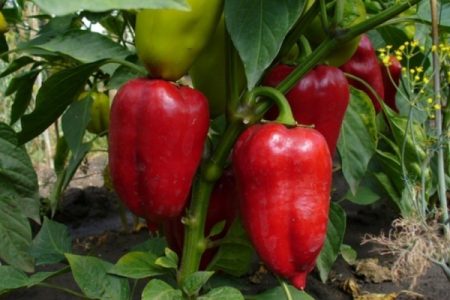
The variety belongs to the type of early ripening plants, since the first fruits can be harvested already 115 days after the appearance of the first sprouts of seedlings. Bushes are of medium height. They do not need to pinch the tops, but require tying the hands with the forming fruits. The fruits have a smooth conical shape and average weight up to 130 - 140 g. The dense juicy pulp has a thickness of 8 mm and at the stage of biological ripening it has a bright orange or red color.
An important advantage of the variety is its ability to maintain an attractive presentation and structural characteristics for 60 - 65 days after harvest. The most dangerous violation in the cultivation of the variety is the lack of moisture supply, since prolonged drying of the soil can lead to a sharp decrease in the number of ovaries forming, as well as to the fact that the bush will dump the already ripened peppers.
Marinkin tongue
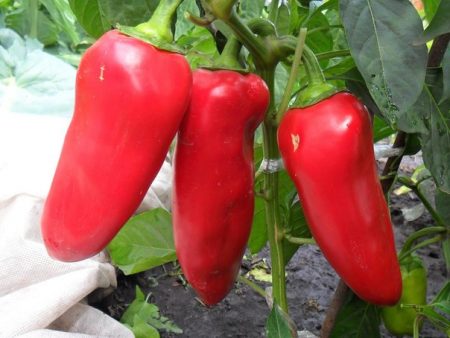
The demand for the variety among experienced gardeners is due to the property of the plants themselves to adapt to various growing conditions, including adverse weather, sharp cooling, and even an aggressive environment.That is why when growing in closed greenhouses, you can count on getting a full crop.
The height of the bushes is about 70 - 75 cm. At the same time, the plants have a wide spreading shape, therefore they require enough space and require binding to an additional support. Grown fruits differ in conical slightly curved shape. The weight of the fruit is approximately 170 - 190 g. The dense juicy pulp has a thickness of 1 cm, which ensures the characteristic crispness of the peppers, as well as their resistance to possible mechanical damage.
Technical ripening of fruits occurs on 110 - 115 days after seedling emergence, and the biological readiness of fruits is characterized by the acquisition of a rich cherry-red tint on 125 - 135 days. Good keeping quality allows the fruits to maintain all the necessary criteria for marketability and quality for 35 - 45 days after the breakdown.
Triton
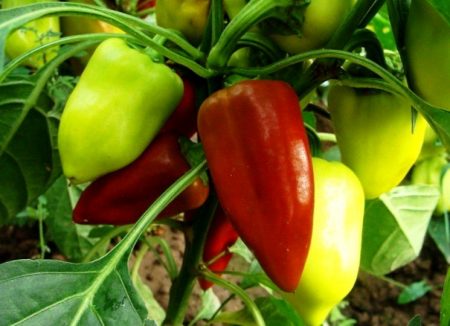
The variety is characterized among gardeners as very early and adapting to different growing conditions. High yields are due to the ability to collect about 35 - 40 fruits of 120 - 140 g each from one bush. The choice of the benefit of the Triton variety is also due to the fact that pepper grows well and forms the ovaries of future fruits in the absence of full sunlight, irregular irrigation and cooling.
In order to have a good harvest, experienced gardeners recommend removing the first ovary, since it is they that inhibit the appearance and development of the rest. At the stage of biological ripening, the fruits are distinguished by a bright yellow-orange or saturated red color, as well as a smooth glossy surface. The shape of the fruit is characterized as a rounded conical shape.
Eroshka
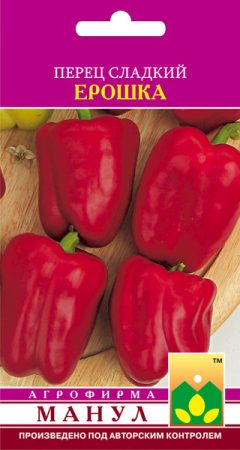
The variety is characterized by early ripening of fruits and their high productivity. The biological maturity of peppers occurs on 120 - 130 days from the moment the first seedlings emerge. You can talk about technical readiness already on the 95th - 110th day of growing seedlings. With proper care from one bush, you can collect at least 10 - 14 full-fledged sweet fruits.
The bushes grow low, about 30 - 50 cm and have a compact compact form. The ripened orange-red cuboid fruits have an average weight of about 140 - 180 g. Due to the compactness of the plants, they can be planted about 10 - 15 pieces per 1 sq. M, observing the distance between the holes of 15 - 20 cm. The fruit ripens together, therefore the harvest is fast enough.
Pound
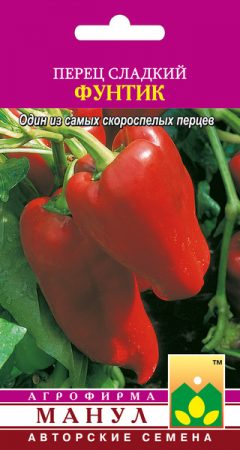
The variety belongs to the category of early ripening high-yielding plants, since the first crops can be harvested already on 100-110 days, and up to 12-17 full sweet crisp peppers are formed on one bush. Full biological ripeness of peppers occurs on 120 - 130 days.
An important advantage of the variety is the optimal height of the bushes of 50 - 70 cm, as well as their compactness, which allows planting at least 5 plants per 1 sq.m. The shape of the fruit is prismatic. Moreover, their average weight is about 140 - 180 g. The thickness of the pericarp reaches 5 - 7 mm. The return of the ripened crop occurs in unison. The variety is resistant to damage by verticillosis and tobacco mosaic. It is recommended to grow peppers in closed greenhouse conditions. Mandatory care is timely moderate watering of the soil and the cliff of the side shoots.
Tenderness
The variety is universal, because it has the ability to adapt to different weather conditions. At the same time, it demonstrates optimal yield when grown in closed greenhouses. The height of the bushes, as a rule, reaches 90 - 100 cm, so the plants require a mandatory careful garter to an additional support. The growing season lasts about 115 - 125 days from the moment the first seedlings emerge. Therefore, the variety is classified as medium early.
The shape of the fruit is pyramidal with a flattened tip.The biological maturity of the fruits is evidenced by their rich red color not only on the glossy peel, but also on the inner juicy pulp. The meaty walls are about 7 - 8 mm thick, and the average weight of the fruit ready to stall is 90 - 110 g. If you follow the growing rules, you can expect to get 7 - 8 kg of juicy sweet fruits from 1 square meter of fertile land.
Gift of Moldova
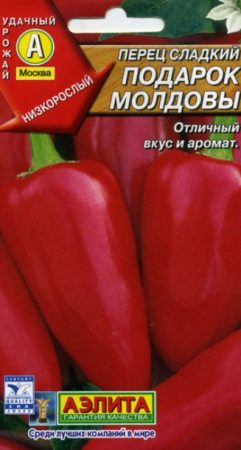
A good yield of bushes allows you to collect about 4.5 - 6 kg of fragrant sweet pepper from 1 square meter of land. Moreover, the growing season takes about 120 - 130 days, which characterizes the variety as a medium early plant. The bushes grow quite low and compact, having only 45 cm in height and a standard shape. This allows you to densely plant plants in a permanent place, which means that you have more yield with limited use of the site.
The fruits themselves are distinguished by their conical shape, average weight of 70 - 80 g, as well as dense sweet flesh with a glossy bright red peel. The variety is resistant to possible lesions of the root system by fusarium.
Chrysolite
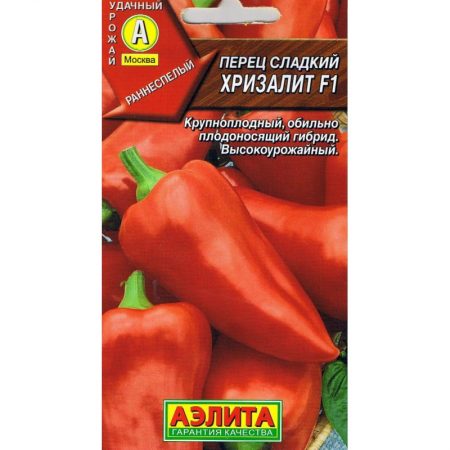
The growing season lasts about 110 - 115 days from the moment of germination of the future seedlings. Pepper is a hybrid; therefore, it is characterized by increased productivity, resistance to sharp changes in growing conditions, but requires the annual purchase of new seeds.
Since the bushes grow quite tall and spreading, brushes with forming and ripening fruits require careful garter to an additional support or trellis method. Ripe fruits are large, bright red and juicy dense pulp. The average weight of peppers is 150-175 g. The thickness of the sweet pulp is about 5-6 mm, which preserves the characteristic crispness of the pepper for a long time after the breakdown.
Subject to the rules of cultivation and care, you can expect to get 12 - 13 kg of crop per 1 sq. M of fertile soil. An important advantage of the variety concerns the high content of ascorbic acid. The variety has medium resistance to apical rot.
Agapovsky
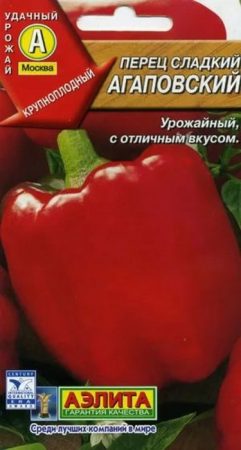
The variety belongs to the category of early ripening plants, since the first ready-made fruits can be expected already on 100 - 120 days from the moment of seedling emergence. Bushes are compact, despite the dense foliage. In this case, the fruits grow large and dense with a glossy red peel. The average weight of peppers is about 115 - 120 g. The thickness of a dense juicy sweet pulp is 5 - 7 mm, which is enough to preserve the crispness of pepper for a long time after harvesting.
Subject to the requirements for care, you can expect to receive 10 - 11 kg of crop per 1 sq.m. The variety has sufficient resistance against damage to the tobacco mosaic and is characterized by an average degree of protection against vertex rot.
Ruza
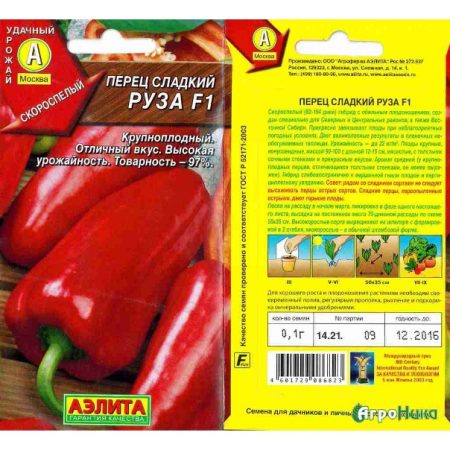
Pepper is an early ripe hybrid and is suitable for cultivation exclusively on closed protected soils. The growing season takes an average of 82 - 105 days. In this case, the bushes grow tall and spreading, which necessitates pinching their tops. Grown fruits differ in large sizes and smooth slightly ribbed conical shape.
At the time of technical maturity, pepper has a green color, which at the time of biological maturation becomes saturated red. The average weight of the fruit is about 70-100 g. The thickness of the sweet juicy pulp is 4-5 mm. With proper cultivation, you can get about 16 - 22 kg of fruit per 1 sq. M plot.
The variety is resistant to injuries of TMV, verticillosis and vertebral rot. Their mandatory care requirements should highlight the moderation of regular watering and 2 - 3 mandatory top dressing of bushes.
Reviews
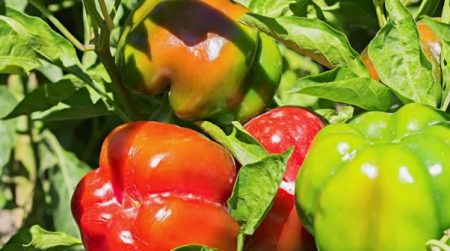
Vladislav Sergeevich, 42 years old
To protect the grown peppers from defeat by fusarium, which is manifested by rotting of the root systems and necks of plants, it is necessary to prevent the formation of puddles and stagnation of water in the ground.In the process of planting seedlings, garlic or onion husks are added to the hole, and even before sowing the seeds into the soil, you can soak them in a weak light pink solution of potassium permanganate for 20-30 minutes.
Veronika Anatolyevna, 38 years old
Preventive two-time treatment of plants with a two-day infusion of celandine saves from damage to the bushes with top rot. To do this, take 10 liters of water and at least 1 - 1.5 kg of freshly chopped grass. Spraying foliage and stems must be carried out using a spray gun. The first treatment is carried out 2 weeks after planting the bushes at a constant place of growth, and re-spraying after a week break. Instead of celandine infusion, a soda solution is also suitable, where 7 to 8 liters of water are taken per 250 g of dry matter. If the first spraying is carried out earlier, then the pepper will not have time to get stronger, and the leaves will suffer from a possible burn and spoilage. This also applies to the use of mineral fertilizers, which must be diluted with water in a ratio of 1 to 10.




 Calorie pepper stuffed with meat and rice - BZHU per 100 grams
Calorie pepper stuffed with meat and rice - BZHU per 100 grams Gorky pepper - the best varieties for open ground
Gorky pepper - the best varieties for open ground Hot pepper seeds - the best varieties for open ground and reviews
Hot pepper seeds - the best varieties for open ground and reviews Capsicum tincture for hair - how to use and reviews
Capsicum tincture for hair - how to use and reviews